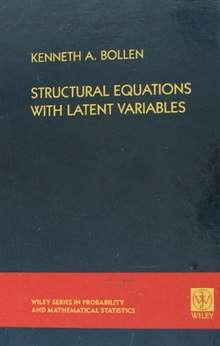Structural Equations with Latent Variables
Structural Equations with Latent Variables is a book by Kenneth Bollen. It explains basic ideas and methods in the field of structural equation modeling[1] and is considered to be an important technical reference.[2][3] It is held to be a classic textbook on the topic.[4][5][6][7]
 | |
| Author | Kenneth Bollen |
|---|---|
| Language | English |
| Subject | Structural equation modeling |
| Publisher | John Wiley & Sons |
Publication date | June 1989 |
| Pages | 528 |
| ISBN | 978-0-471-01171-2 |
Chapters
- Introduction
- Model Notation, Covariances and Path Analysis
- Causality and Causal Models
- Structural Equation Models with Observed Variables
- The Consequences of Measurement Error
- Measurement Models: The Relation between Latent and Observed Variables
- Confirmatory Factor Analysis
- The General Model, Part I: Latent Variables and Measurement Models Combined
- The General Model, Part II: Extensions
Reviews
Bollen’s text, Structural Equations with Latent Variables, represents an authoritative account of covariance structure modeling developments from the perspective of a sociologist who has made important contributions to both the psychometric and sociological literatures on these models.
gollark: No?
gollark: I wonder if I can make any inferences from the *guesses* people made last contest.
gollark: ↓ unless this conflicts with GTech™ aims
gollark: How are YOU not spouting random garbage now?
gollark: EXCELLENT HOLIDAY DESTINATION
References
- Jöreskog, Karl G. (1994). "Structural Equation Modeling with Ordinal Variables". Lecture Notes-Monograph Series. 24: 297–310. JSTOR 4355811.
The basic ideas and methods of structural equation models are explained in Bollen (1989).
- Farkas, George (2005). "Comments on Moran: Learning by Doing or Learning by Studying the History of Statistics? A Response to "The Sociology of Teaching Graduate Statistics"". Teaching Sociology. 33 (3): 272–274. doi:10.1177/0092055x0503300304. JSTOR 4127587.
- "Introduction to Structural Equation Modeling with Latent Variables: Some Important PROC CALIS Features :: SAS/STAT(R) 9.22 User's Guide". SAS Institute. Retrieved January 14, 2017.
- Matsueda, Ross L. (1991). "Reviewed Work: Structural Equations with Latent Variables. by Kenneth A. Bollen". American Journal of Sociology. 96 (6): 1553–1555. doi:10.1086/229704. JSTOR 2781918.
- Clogg, Clifford C. (1991). "Reviewed Work: Structural Equations with Latent Variables. by Kenneth A. Bollen". Contemporary Sociology. 20 (1): 156–158. JSTOR 2072165.
- Zvoch, Keith (2014). "Modern Quantitative Methods for Evaluation Science: Recommendations for Essential Methodological Texts". American Journal of Evaluation. 35 (3): 430–440. doi:10.1177/1098214013514128.
- Rigdon, Edward E. (1994). "Demonstrating the effects of unmodeled random measurement error". Structural Equation Modeling: A Multidisciplinary Journal. 1 (4): 375–380. doi:10.1080/10705519409539986.
- Tanaka, J. S. (June 1990). "Book Review: Structural Equations with Latent Variables". Applied Psychological Measurement. 14 (2): 213–215. doi:10.1177/014662169001400212.
External links
This article is issued from Wikipedia. The text is licensed under Creative Commons - Attribution - Sharealike. Additional terms may apply for the media files.